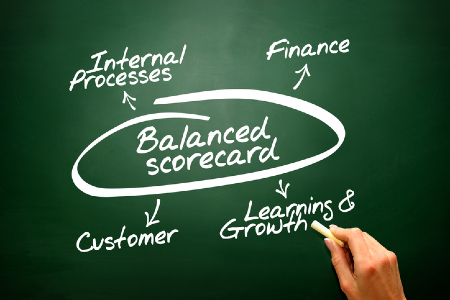The Balanced Scorecard Perspectives Are Too Limiting Now
by Stacey Barr |In the early 1990s, the Balanced Scorecard revolutionised how organisations thought about strategy. But its four perspectives are now too limiting for the era of ESG.

The four perspectives that comprise the Balanced Scorecard are Financial, Customer, Internal Business Processes, and Learning and Growth. And these four perspectives are said to work in a cause-effect flow, from Learning and Growth, through Internal Processes, into Customer, and then to the Financial perspective.
The idea is that you design your strategy across these perspectives, and you choose measures (KPIs) aligned to this strategy, and hence you have your Balanced Scorecard. But can this design still be called balanced?
Balance depends on your purpose.
In the numerous situations where I’ve seen the Balanced Scorecard used over the last few decades, people contort and fit their strategy into those four perspectives. Governments and non-profits might move the perspectives around, to change the cause-effect logic to match their purpose better. Others create their own perspectives, often around popular trends (right now, that’s trends like AI, digital transformation, diversity, ESG, and post-COVID changes to how we work).
Not every organisation exists to serve financial shareholders alone. I’d argue that no organisation or company does.
In an age where social responsibility, environmental responsibility and systems thinking are driving our decisions about what defines organisational success, strategy can no longer contort itself into the Balanced Scorecard’s four perspectives.
Even the creators of the Balanced Scorecard are now rethinking it:
“This re-orientation acknowledges widespread concerns that companies who focus only on their shareholders ignore and may even contribute to the societal problems of environmental degradation, growing inequality, and persistent poverty.” – Robert S. Kaplan and David McMillan
But in that same article, it still feels like they are trying to retrofit today’s broader definition of business responsibilities into those four perspectives. And it doesn’t sit right with me.
The four perspectives are, and always have been, too limiting.
At the same time that the Balanced Scorecard was being published, there were also thought leaders saying we should be thinking about a more complete stakeholder model to guide strategy design. The Performance Prism is one such framework, including investors, customers, employees, suppliers, regulators and communities all as stakeholders. Another model emerging at the same time was TBL or Triple Bottom Line, which moves away from profit as the sole definition of organisational or company success and brings in a new idea of balance, with the People and Planet bottom lines companioning the Profit bottom line.
The Balanced Scorecard positions a single stakeholder group, shareholders, as the ultimate stakeholder of any organisation. Customers are another stakeholder, but only insofar as how satisfying them grows profit for shareholders. Employees are also considered, but again only as inputs to the financial outcomes shareholders want. Other vitally important stakeholder groups are ignored, such as local communities, suppliers and partners, and planet Earth.
Retrofitting social, environmental and governance results into the four perspectives is to treat them too trivially.
Not matter what framework you use to design your strategic direction, if any of the important stakeholders are ignored, that strategic direction will be much harder – if not impossible – to achieve. Stakeholder impact and value needs to be at the centre of any strategy design.
Inform, but don’t constrain, your strategy with frameworks.
No framework or model is correct, but some are useful. The Balanced Scorecard’s greatest usefulness was in how it revolutionised our thinking to include non-financial results and measures into the suite of information we use to manage an organisation or company. And it worked.
There are many frameworks, past and present, that can inform strategy design without unnaturally constraining it. There are dozens of them, as a quick search will reveal. Use those that resonate with you to help you understand the context your organisation or company should succeed in, where the leverage is to create that success, and what care must be taken in the pursuit of that success.
And one more framework that can support your strategy design, without constraining it, is PuMP’s Results Map. Whatever framework you use to design your strategy – to choose strategic perspectives and goals – the Results Map can help you visualise it, cascade it, and link it together in a holistic story of cause-effect, companion and conflict relationships among the results that truly matter.
The Balanced Scorecard’s four perspectives are now too limiting for a world that cares about social and environmental value at least as much as shareholder value. It’s cause-effect theory is now obsolete. [tweet this]
Connect with Stacey
Haven’t found what you’re looking for? Want more information? Fill out the form below and I’ll get in touch with you as soon as possible.
167 Eagle Street,
Brisbane Qld 4000,
Australia
ACN: 129953635
Director: Stacey Barr




